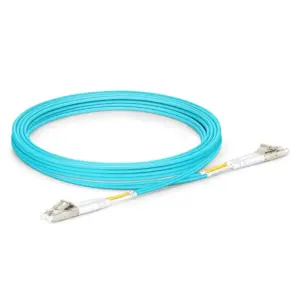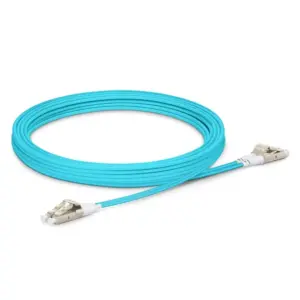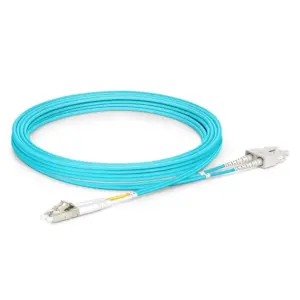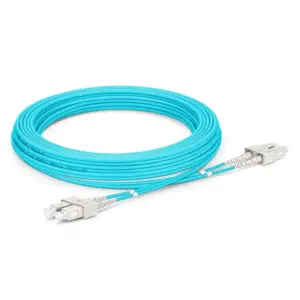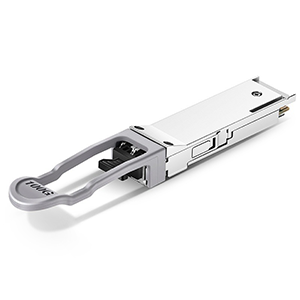As the core infrastructure of the information age, the speed and stability of network connections are crucial to the development of all walks of life. Fiber optic patch cords play a key role in building high-performance networks. OM4 fiber optic patch cord, as a multi-mode fiber with excellent performance, is gradually becoming the first choice for high-speed connections. This article will introduce in detail the definition and characteristics of OM4 optical fiber jumpers, discuss its application fields and transmission performance, and look forward to its future development trends.
Introduction to OM4 optical fiber jumper
OM4 fiber optic patch cord is a kind of multi-mode fiber optic patch cord, which has the characteristics of high bandwidth and low attenuation. It uses high-quality materials and advanced manufacturing processes to support high-speed data transmission and long-distance connections. OM4 level is a type of fiber optic jumper classification, which is superior in performance to OM1, OM2 and OM3 level fiber optic jumpers.
Structure and parameters of OM4 optical fiber jumper
OM4 fiber optic jumper consists of fiber core, cladding and protective sheath. Its core diameter is 50 microns and the cladding diameter is 125 microns. The typical attenuation value is 3.0 dB/km, enabling high-speed, low-loss signal transmission.
Application fields of OM4 optical fiber jumpers
-
Data center network: OM4 optical fiber jumpers are widely used in high-speed data center networks and can support server interconnection, storage area networks and connections between network devices within the data center.
-
Local Area Network (LAN): Local area networks in enterprises and campuses usually require high-speed, reliable connections. OM4 fiber optic patch cords can meet these needs and achieve fast data transmission and reliable communication.
-
High-performance computing: In the field of high-performance computing and supercomputers, OM4 optical fiber jumpers can support large-scale data transmission and high-speed interconnection to meet the needs of complex computing tasks.
Transmission performance of OM4 optical fiber jumper
-
Transmission distance: The maximum transmission distance supported by OM4 fiber optic patch cord depends on the transmission rate. At the 10Gbps rate, the transmission distance can reach 300 meters; at the 40Gbps rate, the transmission distance is 100 meters.
-
Transmission rate: OM4 fiber optic patch cord has excellent performance under different transmission rates. It can support high-speed data transmission of 40Gbps, 100Gbps or even 400Gbps.
Comparison of OM4 fiber optic patch cords with other fiber grades
Compared with OM1, OM2 and OM3 fiber optic patch cords, OM4 fiber optic patch cords have lower attenuation and higher bandwidth. It can provide more reliable and stable signal transmission and is suitable for a wider range of high-speed connection needs.
According to different network environments and needs, choosing OM4 fiber optic patch cords or other fiber optic grades requires comprehensive consideration of factors such as performance requirements, budget constraints, and future scalability.
Precautions for deployment and maintenance of OM4 optical fiber jumpers
When installing and connecting OM4 fiber optic patch cords, you need to follow correct operating procedures and ensure the accuracy and stability of the connection. Regularly clean and maintain fiber optic connections to ensure their performance is not affected by contamination and damage.
The future development trend of OM4 optical fiber jumpers
As network demands continue to grow, OM4 fiber optic patch cords will continue to develop and innovate. Future development trends include:
-
New generation standards: With the advancement of technology, a new generation of standards and specifications for OM4 fiber optic patch cords may emerge to further improve their performance and transmission capabilities.
-
Development of optical fiber networks: With the popularization of optical fiber networks and the expansion of application scope, OM4 optical fiber jumpers will be used in more fields, such as smart cities, Internet of Things, and 5G communications.
Conclusion:
OM4 fiber optic patch cord, as a high-performance multi-mode fiber optic patch cord, has wide application prospects and development potential. It plays an important role in data centers, local area networks, and high-performance computing, promoting the development of information exchange and technological innovation by providing high-speed, reliable connections.
When deploying and maintaining OM4 fiber optic patch cords, we need to follow correct operating procedures and pay close attention to future standards and technology trends. I believe that as technology continues to evolve, OM4 fiber optic patch cords will continue to make an important contribution to the future of high-speed connectivity we build.


